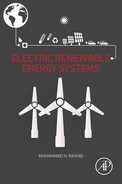Integration of distributed renewable energy systems into the smart grid
Abstract
About 30% of all primary energy resources worldwide are used to generate electrical energy. Since the invention of the electric incandescent light bulb in 1879, the growth of electric power systems progressed at an exponential rate, particularly after the development of AC (alternating current) power generation and the transformer. Transforming AC power from one voltage level to much higher levels meant that losses and voltage drops in the supply lines could be kept at acceptable values. The contribution of different renewable energy sources to the electricity generation mix varies from one country to another, but generally this is currently a small proportion of the total installed capacity. The increase in renewable energy generation involves significant challenges in establishing cost-effective and reliable renewable energy systems in addition to solving the technical problems associated with their connection to the grid. In order to understand the impact of increased connection of RES on the grid and the need for smart grid solutions, it is important first to understand how electricity is currently generated, the characteristics of generation from RES, and some aspects of grid control.
Keywords
20.1. Introduction

20.2. Conventional power generation
20.3. Electricity generation from renewable energy resources
20.3.1. Photovoltaic systems

 (20.1)
(20.1)20.3.2. Wind energy conversion systems
 (20.2)
(20.2)
 (20.3)
(20.3)

20.3.3. Other renewable energy resources
20.4. Grid connection of distributed RES
20.4.1. Grid interface of PV systems


20.4.2. Grid interface of WECS
20.4.2.1. Fixed-speed wind turbine

20.4.2.2. Variable-speed wind turbines


20.4.3. Grid interface of other RES
20.5. Distributed renewable energy sources
20.5.1. Benefits of distributed RES
20.5.2. Impact of distributed RES on the grid


20.5.3. Islanded operation and microgrids
20.6. Voltage control in power networks
20.6.1. Voltage drop in feeders


 (20.6)
(20.6)
 (20.7)
(20.7)
 (20.8)
(20.8)
 (20.9)
(20.9)20.6.2. Voltage control using tap changers on distribution transformers


20.6.3. Voltage fluctuation (flicker)


 (20.10)
(20.10)
 (20.11)
(20.11)20.7. Power quality and harmonics
20.7.1. Definitions and impact of RES
20.7.2. Harmonics effects and solutions

(a) Power circuit and (b) harmonic spectrum.
20.7.3. Limits of harmonic current distortion
Table 20.1
Current distortion limits (in percent of IL) for general distribution systems (120 V to 69 kV)
| Order | 3 ≤ h < 11 | 11 ≤ h < 17 | 17 ≤ h < 23 | 23 ≤ h < 35 | 35 ≤ h ≤ 50 | TDD |
| Limit | 4% | 2% | 1.5% | 0.6% | 0.3% | 5% |
![]()
Adapted from Ref. [29].
TDD, total demand distortion.
Table 20.2
Planning levels of harmonic voltages in 400 V systems
| Odd harmonics (nonmultiples of three) | Odd harmonics (multiples of three) | Even harmonics | |||
| Order “h” | Harmonic voltage (%) |
Order “h” | Harmonic voltage (%) |
Order “h” | Harmonic voltage (%) |
| 5 | 4 | 3 | 4 | 2 | 1.6 |
| 7 | 4 | 9 | 1.2 | 4 | 1.0 |
| 9 | 3 | 15 | 0.3 | 6 | 0.5 |
| 13 | 2.5 | 21 | 0.2 | 8 | 0.4 |
| 17 | 1.6 | >21 | 0.2 | 10 | 0.4 |
| 19 | 1.2 | 12 | 0.2 | ||
| 23 | 1.2 | >12 | 0.2 | ||
| 25 | 0.7 | ||||
| >25 | 0.2 + 0.5(25/h) | ||||

Adapted from Ref. [27].
Adapted from [27] Table 2, page 10.
Table 20.3
Compatibility levels for individual harmonic voltages in low and medium voltage networks (percent of fundamental components) [3]
| Odd harmonics (nonmultiples of three) | Odd harmonics (multiples of three) | Even harmonics | |||
| Order “h” | Harmonic voltage (%) |
Order “h” | Harmonic voltage (%) |
Order “h” | Harmonic voltage (%) |
| 5 | 6 | 3 | 5 | 2 | 2 |
| 7 | 5 | 9 | 1.5 | 4 | 1.0 |
| 11 | 3.5 | 15 | 0.4 | 6 | 0.5 |
| 13 | 3 | 21 | 0.3 | 8 | 0.5 |
| 17≤ h ≤ 49 | 2.27 × 17/h – 0.27 | 21< h ≤ 45 | 0.2 | 10 ≤ h ≤ 50 | 0.25 × 10/h + 0.25 |

20.8. Regulations for connection of distributed RES to the grid
Table 20.4
UK engineering recommendations that cover the connection of distributed generation to the electrical distribution network
| Engineering recommendations | Generator rated power (Prated) | Voltage at PCC |
| G75 | Prated ≥ 5 MW | Vrated ≥ 20 kV |
| G59 | 11.1 kW < Prated < 5 MW | 400 V ≤ Vrated ≤ 20 kV |
| G83 | Three-phase: Prated ≤ 11 kW | Vrated = 400 V |
| Single-phase: Prated ≤ 3.7 kW | Vrated = 230 V |

Adapted from Ref. [32].
Table 20.5
US FERC distributed generation connection requirements
| Engineering recommendations | Generator rated power Prated | Installation requirements |
| FERC order 2003a | Prated > 20 MW | Full engineering evaluation of impact on system |
| FERC order 2006 | 2 MW < Prated < 20 MW | Full engineering evaluation of impact on system |
| Prated < 2 MW | Fast track restricted evaluation of impact on system | |
| Prated ≤ 10 kW | Application form-based permission for installation of certified inverter-based generators |

20.9. Smart grid solutions



